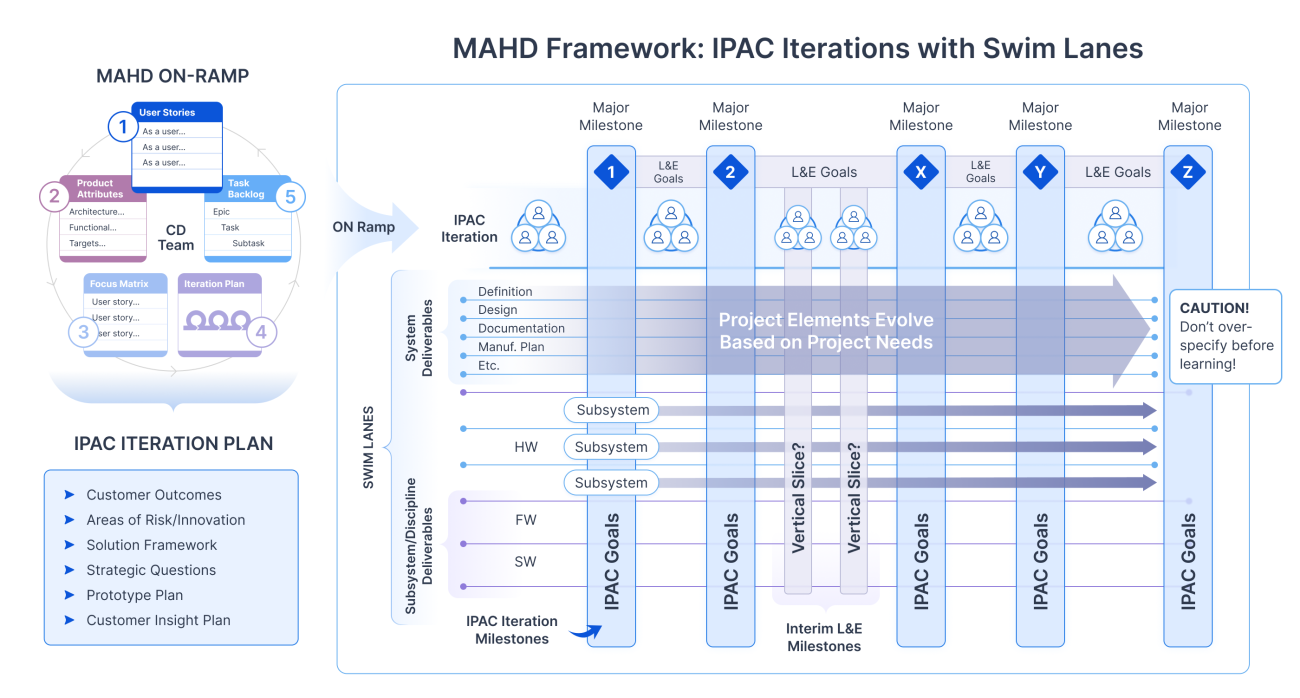Building an Agile Electronics Project Management Plan with Jira

Managing software projects in Jira is straightforward: build a backlog of user stories and technical tasks, prioritize them, select the top ones for execution in the upcoming sprint, and voila! You are managing the project.
Unfortunately, as shared in previous articles, this doesn’t work for hardware.
Why "Normal" Agile Project Management Struggles for Hardware
You need early architectural clarity, coordination across EE/FW/ME/Supply Chain, the ability to track progress for evolving solutions, and the means to communicate schedules to the satisfaction of executives.
The answer isn’t abandoning agile or Jira; it’s:
- Using agile-for-hardware methods (such as those provided by the MAHD Framework) with agile tactics that support the needs of electronics
- And setting up Jira to support these methods.
Below is a proven, three-anchor agile-based project management plan you can run in Jira without burying your teams in an infinite hierarchy of tasks and endless planning ceremonies.
1. Vision Brief: The Plan’s North Star
Purpose: This essential agile for hardware tool aligns leadership, marketing, and engineering on why the product exists, what success looks like, and non-negotiable constraints. Equally crucial, it provides the source of truth to guide difficult tradeoff decisions efficiently as the team gets mired in technical details.
Making It Work in Jira
The key to tracking the big picture in Jira is using a combination of Confluence pages, epics, and links.
- Start with a single Epic: Vision Brief and link a short Confluence page (problem, target customer, market, and project success factors, constraints, etc.)
- Add custom fields to the Epic (e.g., Success Factors, Constraints) so the truth lives where work lives.
- Connect the deliverables to these key project success factors using links and tags, rather than attempting to create a hierarchy of tasks to deliver on each element.
- Create a custom progress flow - e.g., No Progress, Path Identified, WIP-33%, WIP-66%, Validation, Proven - focused on value delivery rather than tasks. Tailor it to your team, as this distinction is key to maintaining an agile mindset over traditional execution.
Outcome: By starting with clear intent, stakeholders argue less about features and dates, more about outcomes, guardrails, and hitting strategic goals.
2. On-Ramp: Get Just Enough Architecture and Risk on the Table
As shown in Figure 1 below and discussed in the previous article, agile hardware projects require a project management approach that considers the range of disciplines, subsystems, deliverables, and system needs. This is best managed as aligned swim lanes.
Before diving into project details, teams must set the stage for success by configuring management tools and backlogs to fit project needs. Instead of traditional detailed requirements or work breakdowns, an agile approach built on MAHD on-ramp steps provides a faster, more collaborative path. These quick, efficient activities help teams define a realistic, adaptable plan and establish clarity before execution, including:
- System-level outcomes: Capture and prioritize the “what/why” as system stories (not detailed tasks).
- Product attributes: Agree on the technical factors that drive decisions (power, RF boundaries, size, compliance, etc.) that become the skeleton solution that will evolve.
- Matrixed clarity (Focus Matrix): An essential step to map system stories ↔ attributes to reveal hot spots, dependencies, and early experiments.
- Prototype path: Identify the build waypoints (Proto-A, EVT, DVT, PVT) and the purpose for each.
Making It Work in Jira
The fundamental challenge to managing agile hardware projects in Jira (or any project management tool) is that they are primarily structured for hierarchies of tasks, not the matrixed challenge of tracking progress, deliverables, and connections in parallel.
Some tips to make this work in Jira.
- Leverage Confluence: Where it makes sense to track artifacts that don’t fit a natural hierarchy, use Confluence pages and links. A good example is the system architecture and definition. As this will evolve, develop it in sections in one or more Confluence Pages.
- Adopt swim lanes: As you can’t manage a hardware project with one long backlog, break it into logical swim lanes for subsystems and system deliverables.
- Don’t skimp on Epics: Define system outcomes (user stories), deliverables in each swim lane, etc. as epics to track and see progress. Only assign tasks to those epics that have a specific natural breakdown of work. For those that require work across swim lanes, use links to build connections and traceability.
- Add versions for Iteration outcomes: Proto-A, EVT, DVT, with target dates. Iteration plans can be tracked in Confluence or another best tool for your project.
Outcome: With an on-ramp approach, teams turn uncertainty into a visible, adaptable plan that evolves toward the best solution with minimal effort and risk. This includes a schedule that reflects the team’s best estimate and becomes more accurate as they learn and execute.

3. Learning and Execution Cycles: Iterate with IPAC-Style Goals
Making It Work in Jira
Iteration planning must be a team event where all can see the big picture while working through the specific goals for the next IPAC Iteration. This can be difficult in project management tools. Some tips to make this work:
- Leverage Links: Track the IPAC Iteration plan on a Confluence page with line items that match your swim lane setup in Jira. Link each Iteration goal to an epic in Jira.
- Manage Acceptance Criteria: Plan two-week sprints in the backlog, but “done” is judged at the iteration level: Integrations Tested, Prototypes Developed, Partners and Other Stakeholders Aligned, Customer Feedback Captured (IPAC).
- Create a High-level View: Track iteration work on team boards; roll up to a Program board that shows dependencies, prototype versions, and swim lane deliverable outcomes.
Outcome: Agile-for-hardware methods with Jira create a consistent, transparent path to project success, ensuring management adds value rather than pain. Using simple Confluence tables linked to Jira epics, teams minimize overhead while staying focused and on track.
How Does an Agile Approach Differ from Traditional?
With an agile approach, you don’t lose project discipline as some who are unfamiliar with a modified agile approach may believe, rather you change how discipline is obtained. Here’s a quick translation of ten traditional project management tools and how the intention is optimized in agile projects.
|
Traditional PM Tool |
Typical Use |
Agile-for-Hardware Approach |
Agile Benefits |
How to Manage In Jira/Confluence |
|
Program Charter |
Use once to set purpose |
Agile Vision Brief |
Living strategic guidance |
Maintain and link in Confluence. Elements as Jira epics. |
|
Gantt as “the plan” |
Predict long chains up front |
Vision Brief + IPAC Iteration Plans |
Big picture with real progress |
Iteration plans in Confluence, tracking details in Jira. |
|
Requirements doc |
Big spec early – the “contract” |
Evolving system outcomes + attributes |
Optimized outcomes |
System stories + attributes; Confluence index page |
|
WBS (static) |
Decompose once |
Living plan |
Collaborative and adaptable |
Jira swim lanes and epics->tasks |
|
Stage-gate |
Big decisions at far-apart gates |
Frequent “gatelets” each cycle (IPAC review) |
Transparent, learning based progress |
Recurring review; Confluence notes + Decisions tracking |
|
Critical Path |
Focus only on the longest chain |
Dependency radar across subsystems |
Consistent, continuous focus |
Issue links (blocks/is blocked by); Program board; JQL filters |
|
Change Control Board |
Slow, centralized approvals |
Lightweight change policy tied to cycle goals |
Faster, strategic decisions that stick |
Confluence, epic workflow support |
|
Weekly status deck |
Manual deck churn – action items |
Live dashboards + I-plan progress |
Team-based assessment - reality |
Exec dashboard: milestones/risks; Team dashboard: project health |
|
Earned Value |
% complete vs. plan |
Evidence-based burn-down from Iterations |
Real vs. paper progress |
Swim lanes for Risk Burned; IPAC goals |
|
Risk register (mostly static) |
Spreadsheet on shared drive |
Risk-mitigation central to team planning |
Significantly improved project risk profiles |
Risk tracked in swim lanes throughout project |
Some Patterns to Avoid
It may be tempting to blend traditional project management approaches, such as Gantt charts and status reports, with an agile way of working. This can be acceptable depending on your organization’s needs, but proceed with caution. Some things to avoid:
- Treating Iterations as mini-waterfalls. Don’t try to make each Iteration be the same as traditional stages. You’ll lose much of the value of agile.
- Adopt every software practice. Daily standups should not be mandatory. Task estimation should only involve those with subject matter expertise and acceptance criteria should be focused at the Iteration level. Make sure every artifact and ceremony makes sense for your project.
- Treating the process as development management. Agile for hardware must be considered a market success process with active involvement with product management, executives, and all stakeholders.
In Conclusion
Jira can provide the structure you need as a project manager while giving teams the agility hardware demands: Vision Brief → On-Ramp → IPAC-style cycles, all wired into Jira so status is live and tied to real outcomes.
For more details on agile-for-hardware methods, download our whitepaper “Modified Agile for Electronics Development - A Smarter Path to High-Value Solutions”.











